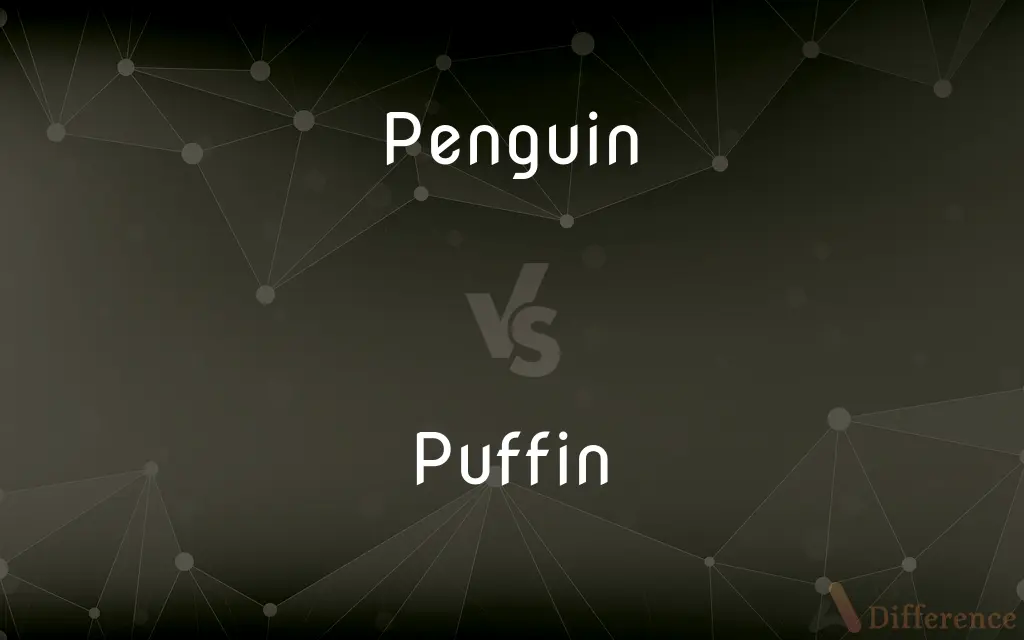Penguin vs. Puffin — What's the Difference?
By Fiza Rafique & Urooj Arif — Updated on March 21, 2024
Penguins are flightless seabirds known for their distinctive black and white plumage and living primarily in the Southern Hemisphere, whereas puffins are smaller, colorful seabirds capable of flight, found in the Northern Hemisphere.

Difference Between Penguin and Puffin
Table of Contents
ADVERTISEMENT
Key Differences
Penguins are adapted to life in the water, with their bodies streamlined for swimming. Their wings have evolved into flippers used for propulsion underwater, making them excellent swimmers but incapable of flight. Puffins, on the other hand, have wings adapted for both flying and swimming, allowing them to dive into the water to catch fish while still being able to fly.
The habitat of penguins is largely restricted to the Southern Hemisphere, with many species living in cold environments, such as Antarctica. Puffins live in the Northern Hemisphere, primarily on the coasts of the North Atlantic Ocean, where they nest in cliffside colonies during the breeding season.
Penguins are known for their black and white coloration, which provides camouflage in the water. Their white bellies blend with the light when seen from below, and their dark backs merge with the oceanic depths when seen from above. Puffins are more colorful, with black and white bodies but distinctive bright orange beaks and feet, which are especially vivid during the breeding season.
Diet-wise, both penguins and puffins primarily feed on fish, squid, and other small marine organisms. However, their hunting methods differ. Penguins catch their prey while swimming underwater, using their speed and agility. Puffins dive from the air into the water, using their wings to "fly" underwater and catch fish.
Social behavior varies between the two as well. Penguins are highly social and breed in large colonies; some colonies can include thousands of individuals. Puffins also breed in colonies but tend to be more solitary or in small groups when at sea.
ADVERTISEMENT
Comparison Chart
Flight Ability
Flightless, with wings evolved into flippers
Capable of flight, with wings adapted for flying and swimming
Habitat
Primarily Southern Hemisphere, cold environments
Northern Hemisphere, coastal North Atlantic
Appearance
Black and white plumage for camouflage
Colorful, with bright orange beaks and feet
Diet
Fish, squid, using speed underwater
Fish, diving from the air, "flying" underwater
Social Behavior
Highly social, large breeding colonies
Breed in colonies, solitary or small groups at sea
Compare with Definitions
Penguin
Habitat.
Many penguins live in Antarctica, thriving in cold conditions.
Puffin
Flight.
Puffins can fly, covering long distances to find food.
Penguin
Adaptation.
Penguins are adapted for swimming, with streamlined bodies and flippers.
Puffin
Habitat.
Puffins are found in the North Atlantic, nesting on rocky cliffs.
Penguin
Social Structure.
They form large colonies for breeding and social interaction.
Puffin
Feeding.
Puffins dive into the water from the air to catch fish.
Penguin
Camouflage.
Their black and white plumage helps them blend into their aquatic environment.
Puffin
Social Behavior.
While they breed in colonies, puffins are often seen alone or in small groups while at sea.
Penguin
Feeding.
Penguins catch prey underwater, using their flippers for propulsion.
Puffin
Appearance.
Their bright beaks and feet are distinctive, especially in breeding season.
Penguin
Penguins (order Sphenisciformes , family Spheniscidae ) are a group of aquatic flightless birds. They live almost exclusively in the Southern Hemisphere, with only one species, the Galápagos penguin, found north of the Equator.
Puffin
Puffins are any of three species of small alcids (auks) in the bird genus Fratercula. These are pelagic seabirds that feed primarily by diving in the water.
Penguin
Any of various stout, flightless aquatic birds of the family Spheniscidae, of the Southern Hemisphere, having flipperlike wings and webbed feet adapted for swimming and diving, short scalelike feathers, and white underparts with a dark back.
Puffin
Any of several seabirds of the genus Fratercula of northern regions, characteristically having black-and-white plumage and a vertically flattened, triangular bill that is brightly colored during breeding season.
Penguin
(Obsolete) The great auk.
Puffin
The young of the Manx shearwater (Puffinus puffinus), especially eaten as food.
Penguin
Any of several flightless sea birds, of order Sphenisciformes, found in the Southern Hemisphere, marked by their usual upright stance, walking on short legs, and (generally) their stark black and white plumage.
Puffin
The Atlantic puffin (Fratercula arctica) or (by extension) any of the other various small seabirds of the genera Fratercula and Lunda that are black and white with a brightly-coloured beak.
Penguin
An auk (sometimes especially a great auk), a bird of the Northern Hemisphere.
Puffin
(entomology) Any of various African and Asian pierid butterflies of the genus Appias. Some species of this genus are also known as albatrosses.
Penguin
(slang) A nun (association through appearance, because of the often black-and-white habit).
Puffin
(obsolete) A puffball.
Penguin
(juggling) A type of catch where the palm of the hand is facing towards the leg with the arm stretched downward, resembling the flipper of a penguin.
Puffin
An arctic sea bird Fratercula arctica) allied to the auks, and having a short, thick, swollen beak, whence the name; - called also bottle nose, cockandy, coulterneb, marrot, mormon, pope, and sea parrot.
Penguin
A spiny bromeliad with egg-shaped fleshy fruit, Bromelia pinguin.
Puffin
The puffball.
Penguin
A member of the air force who does not fly aircraft.
Puffin
A sort of apple.
Penguin
Any bird of the order Impennes, or Ptilopteri. They are covered with short, thick feathers, almost scalelike on the wings, which are without true quills. They are unable to fly, but use their wings to aid in diving, in which they are very expert. See King penguin, under Jackass.
Puffin
Any of two genera of northern seabirds having short necks and brightly colored compressed bills
Penguin
The egg-shaped fleshy fruit of a West Indian plant (Bromelia Pinguin) of the Pineapple family; also, the plant itself, which has rigid, pointed, and spiny-toothed leaves, and is used for hedges.
Penguin
Short-legged flightless birds of cold southern especially Antarctic regions having webbed feet and wings modified as flippers
Common Curiosities
Do penguins have any natural predators?
Yes, penguins have natural predators such as seals, sharks, and sea lions.
Why are puffin beaks so colorful?
The bright colors of a puffin's beak play a role in attracting mates and signaling breeding condition.
How do puffins navigate long distances?
Puffins use their strong flying abilities and visual landmarks to navigate over the ocean.
Can penguins swim as soon as they are born?
Penguin chicks need time to develop waterproof plumage before they can swim.
How do penguins stay warm in cold environments?
Penguins have a layer of fat under their skin and dense, waterproof feathers to keep warm.
Can penguins live in the North Pole?
No, penguins are native to the Southern Hemisphere and are not found in the Arctic.
What conservation efforts are in place for penguins and puffins?
Conservation efforts include habitat protection, research, and monitoring populations to ensure the survival of both penguin and puffin species.
How do puffins build their nests?
Puffins typically dig burrows in cliff sides or use crevices among rocks for nesting.
Are penguins social outside of breeding seasons?
Yes, penguins often stay in groups throughout the year for feeding and protection.
How often do penguins and puffins breed?
Most species breed once a year, with specific timing depending on the species and environmental conditions.
What threats do puffins face?
Puffins face threats from habitat loss, climate change, and overfishing, which affects their food supply.
What role do penguins play in their ecosystem?
Penguins are important predators in their marine ecosystems, helping to regulate populations of fish and other prey.
Can puffins be found in regions other than the North Atlantic?
While most commonly associated with the North Atlantic, puffins can also be found in the North Pacific Ocean.
How do puffins and penguins differ in their flying and swimming abilities?
Penguins are adapted to swim but cannot fly, using their flippers underwater. Puffins can both fly in the air and "fly" underwater using their wings.
What adaptations help puffins catch fish?
Puffins have specially adapted beaks that allow them to hold several fish at once while swimming.
Share Your Discovery

Previous Comparison
Mackerel vs. Kipper
Next Comparison
Calash vs. CarriageAuthor Spotlight
Written by
Fiza RafiqueFiza Rafique is a skilled content writer at AskDifference.com, where she meticulously refines and enhances written pieces. Drawing from her vast editorial expertise, Fiza ensures clarity, accuracy, and precision in every article. Passionate about language, she continually seeks to elevate the quality of content for readers worldwide.
Co-written by
Urooj ArifUrooj is a skilled content writer at Ask Difference, known for her exceptional ability to simplify complex topics into engaging and informative content. With a passion for research and a flair for clear, concise writing, she consistently delivers articles that resonate with our diverse audience.














































